Introduction
Puawānanga - Clematis species
Māwhai - Sicyos species
Kōhia - Passiflora tetrandra
Pōhue - Calystegia sp.
Pōhuehue - Muehlenbeckia spp.
References, Acknowledgements and Gallery.
In most Eastern Polynesian languages, pōhue or the reduplicated form pōhuehue (and their equivalents) are generic terms for beach creepers, especially species of Convolvulus and Ipomoea. In this respect these words take on the sense of the Proto Polynesian and Proto Oceanic words (*fue and *puRe, respectively) from which they are ultimately derived. In Māori and the other Eastern Polynesian languages, the direct reflex of the older words, *hue, came to refer primarily to either or both the fruit and the vine of the bottle gourd, Lagenaria siceraria.
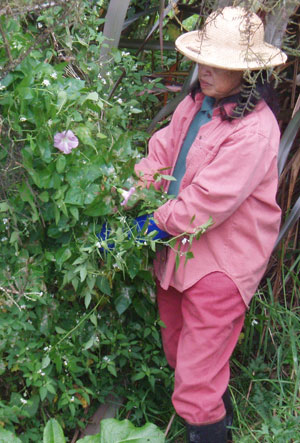 The Māori reflexes of Proto Eastern Polynesian *Pōhue follow this pattern, with pōhue referring especially to the native bindweed, a subspecies of Calystegia sepium, and the reduplicated forms, pōhuehue and pōpōhue functioning interchangeably as generic terms for a group of vigorous vines from several disparate plant families with a predeliction for scrambling over shrubs and small trees. The iconic pōhue are probably Calystegia sepium subsp. roseata and the three best-known species of Muelhenbeckia (M. complexa, M. axillaris and M. australis), the latter group often referred to simply as pōhuehue, although they each have alternative names of their own. The Māori reflexes of Proto Eastern Polynesian *Pōhue follow this pattern, with pōhue referring especially to the native bindweed, a subspecies of Calystegia sepium, and the reduplicated forms, pōhuehue and pōpōhue functioning interchangeably as generic terms for a group of vigorous vines from several disparate plant families with a predeliction for scrambling over shrubs and small trees. The iconic pōhue are probably Calystegia sepium subsp. roseata and the three best-known species of Muelhenbeckia (M. complexa, M. axillaris and M. australis), the latter group often referred to simply as pōhuehue, although they each have alternative names of their own.
The tropical Polynesian plants sharing the names derived from *pōhue are also wild plants, many of which, like the New Zealand Calystegia, despite the beauty of their flowers no doubt became weeds when they appeared on cultivated land. Because of its heritage status, C. sepium is guaranteed a place in Te Māra Reo, but when it starts scrambling up kahikatea and other trees (like the vine in the photograph at the left) it has to be restrained with determination and vigour.
Puawānanga - Clematis species
The most spectacular of this group of plants in Aotearoa are the nine native species of Clematis, all endemic to the country. Three widely-distributed species are featured here: C. paniculata, C. forsteri and C. foetida.
Despite its strong pleasant fragrance and presence in forests throughout the country except for Taranaki and much of the eastern half of the South Island from North Otago to Marlborough, Clematis foetida does not seem to have earned a name of its own apart from the generic pōhuehue and variants, and another generic name for Clematis and other climbers, puatororaro. The Latin specific name is an undeserved slight -- it is not in the least evil-smelling. Male and female flowers are borne separately, the male flowers around an inch in diameter, the female flowers slightly smaller, both heavily scented with greenish to yellow sepals (Clematis flowers do not have petals). Like most Clematis, it is a vigorous climber, with stems reaching 6 metres and more through shrubs and trees on the forest margins. The flowering season is from November to January.
Clematis paniculata, also known as puawānanga, pikiarero, puapua, and puataua (and variants), another denizen of the forest margins, is known for its large fragrant white flowers, up to 10 cm in diameter. Male and female flowers appear on separate plants in late winter, when Rehua (Antares), the star of the summer, has risen above the horizon. In Māori tradition, Rehua is the father of the puawānanga; their mother is Puanga (Rigel), the star of the New Year, appearing about the same time as Matariki and the bringer of food. The peppery leaves, according to Tony Foster (Plant Heritage NZ), were a remedy for toothache. The flowering season extends from August to November, after which the tiny single-seeded fruits appear with their conspicuous silky plumes attached.
Clematis forsteri, also known as pikiarero and puawānanga (and formerly as C. hexasepala because of its 6-sepalled flowers), is a slender rapid-growing vine with fragrant white flowers, 3-4 cm in diameter. It flowers from October to January. The leaves were used for treating skin problems (they have a blistering effect), and the bitter juice from the stems provided a means to deter children from suckling. This vine is found in forest margins in the North Island from Auckland south, and in the northern half of the South Island.
Hoki atu ki runga -- Go back to the top of the page.
Māwhai - Sicyos species
This name is probably a reflex of Proto-Polynesian *Maafaqi.
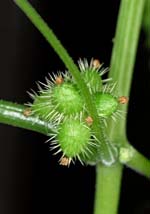 New Zealand has two native members of the gourd family, both also known as māwhai, the endemic Sicyos mawhai, and S. australis, which is found also in Australia and Norfolk and Lord Howe Islands. Both species have small, spiny fruit (those of S. mawhai are illustrated on the left; the fruit of S. australis are also borne in clusters; the individual fruit of S. australis are even smaller than those of S. mawhai, the largest measuring less than 1cm by 4 mm wide. When they are not fruiting they are very similar in general appearance and habit of growth to the choko, scrambling and climbing over and up whatever foliage is in their path. Their tendrils are very sensitive, allowing them to grasp anything suitable for climbing within a few minutes if touching it. The leaves are a lighter green than those of the choko, and the choko's fruit is very much larger. Even the prickliest variety of choko cannot match the ferocity of the mawhai's protective spines. They do however belong to the same branch of the gourd family (the choko, Sechium edule, was once known as Sicyos edule). Andrew Crowe (Field Guide, p. 157) has an interesting quote from a nineteenth century observer regarding the use of this plant being "boiled for greens" in "native villages" in Aotearoa and Hawai'i. The Hawaiians were probably using one of the 14 local species of Sicyos for this purpose -- the leaves at the tips of choko stems also make good greens. New Zealand has two native members of the gourd family, both also known as māwhai, the endemic Sicyos mawhai, and S. australis, which is found also in Australia and Norfolk and Lord Howe Islands. Both species have small, spiny fruit (those of S. mawhai are illustrated on the left; the fruit of S. australis are also borne in clusters; the individual fruit of S. australis are even smaller than those of S. mawhai, the largest measuring less than 1cm by 4 mm wide. When they are not fruiting they are very similar in general appearance and habit of growth to the choko, scrambling and climbing over and up whatever foliage is in their path. Their tendrils are very sensitive, allowing them to grasp anything suitable for climbing within a few minutes if touching it. The leaves are a lighter green than those of the choko, and the choko's fruit is very much larger. Even the prickliest variety of choko cannot match the ferocity of the mawhai's protective spines. They do however belong to the same branch of the gourd family (the choko, Sechium edule, was once known as Sicyos edule). Andrew Crowe (Field Guide, p. 157) has an interesting quote from a nineteenth century observer regarding the use of this plant being "boiled for greens" in "native villages" in Aotearoa and Hawai'i. The Hawaiians were probably using one of the 14 local species of Sicyos for this purpose -- the leaves at the tips of choko stems also make good greens.
S. australis is found in the North Island from Waikato to the Bay of Plenty north, in coastal environments and inland forest, although it is now becoming rare and classified as "at risk". The endemic species was once quite common throughout the northern half of the North Island, the Marlborough Sounds, and on many off-shore islands; it is now extinct in most of these previous habitats, and confined to a few remote places like the Kermadec and Three Kings Islands. It is thought that both species may have been adversely affected by the viruses imported with exotic members of the Cucurbitaceae, such as the zucchini mosaic virus, as well as the usual changes in land use and other disruptions of their old habitats.
Kōhia - Passiflora tetrandra
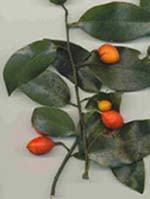 Passiflora tetrandra, more commonly called kōhia, is another member of the pōhue/pōhuehue group and occasionally goes one or other of those names. It is also known as akakōhia, akakaikū, akakaikūkū, akakūkū and akatororaro (names incorporating the word-root aka "vine"), as well as kāhia, kohe, and kaimanu. The last name, literally "bird food", has probably been bestowed because in its natural state the bright orange fruits (about the size of a small plum -- illustrated to the left) appear mostly at the end of the vine high up on the forest trees, accessible chiefly by birds and possums. The alternative names with kū as a component note the fondness of the native pigeons (kūkū or kererū), Hemiphaga novaeseelandiae, for including this fruit in their diet. There is a separate page devoted to this plant, so no more need be said about it here. Passiflora tetrandra, more commonly called kōhia, is another member of the pōhue/pōhuehue group and occasionally goes one or other of those names. It is also known as akakōhia, akakaikū, akakaikūkū, akakūkū and akatororaro (names incorporating the word-root aka "vine"), as well as kāhia, kohe, and kaimanu. The last name, literally "bird food", has probably been bestowed because in its natural state the bright orange fruits (about the size of a small plum -- illustrated to the left) appear mostly at the end of the vine high up on the forest trees, accessible chiefly by birds and possums. The alternative names with kū as a component note the fondness of the native pigeons (kūkū or kererū), Hemiphaga novaeseelandiae, for including this fruit in their diet. There is a separate page devoted to this plant, so no more need be said about it here.
Hoki atu ki runga -- Go back to the top of the page.
Pōhue - Calystegia spp.
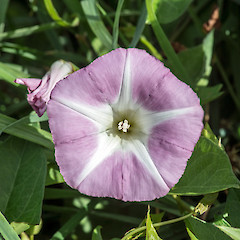 Possibly the most frequently encountered pōhue is Calystegia sepium subsp. roseata, which is generally known by that name alone, although apart from akapōhue and other variants of pōhue, like other plants in this group it does have several aliases: nahinahi, panahi, panake, and raukawa. It has a pink flower with a distinctive white 5-pointed star radiating from the centre, as illustrated by the picture on the left. There is also a special term for its larger roots, which once served as a famine food: rarotawake. In the nineteeenth century and earlier the roots were dried, stored, and then when needed soaked in water and cooked in a hāngi. The cooked leaves were also eaten. It was said to go best with kōkihi (Tetragonia tetragonioides, "NZ Spinach") and hākehakeha (Auricularia polysticha), a fungus that grows on dead karaka trees, among others. Possibly the most frequently encountered pōhue is Calystegia sepium subsp. roseata, which is generally known by that name alone, although apart from akapōhue and other variants of pōhue, like other plants in this group it does have several aliases: nahinahi, panahi, panake, and raukawa. It has a pink flower with a distinctive white 5-pointed star radiating from the centre, as illustrated by the picture on the left. There is also a special term for its larger roots, which once served as a famine food: rarotawake. In the nineteeenth century and earlier the roots were dried, stored, and then when needed soaked in water and cooked in a hāngi. The cooked leaves were also eaten. It was said to go best with kōkihi (Tetragonia tetragonioides, "NZ Spinach") and hākehakeha (Auricularia polysticha), a fungus that grows on dead karaka trees, among others.
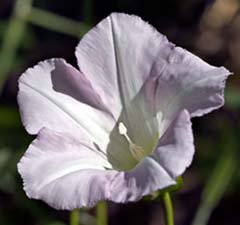 However, this plant, which is indigenous to Aotearoa and other parts of the Southern Hemisphere, has interbred in New Zealand with the European species C. silvatica, which has highly purgative properties, making the local plants, also with laxative after-effects but much milder in their original form, generally unsafe to eat. The European species has broader leaves than the indigenous one, and larger white flowers. The hybrids have pinkish flowers with pale white stripes, as in the photograph on the right. However, this plant, which is indigenous to Aotearoa and other parts of the Southern Hemisphere, has interbred in New Zealand with the European species C. silvatica, which has highly purgative properties, making the local plants, also with laxative after-effects but much milder in their original form, generally unsafe to eat. The European species has broader leaves than the indigenous one, and larger white flowers. The hybrids have pinkish flowers with pale white stripes, as in the photograph on the right.
Murdoch Riley recounts that the origin of the pōhue is attributable to "a lady whose indiscreet behaviour caused the celestial atua to be offended" -- as a result, among other things, the kumara she planted became pōhue.
In its pristine state, the pōhue was a symbol of security in hard times, albeit not a particularly attractive one:
He aha? He kai mā tāua?
... Ā, he pōhue, toro ki te whenua.
What? There's food for us?
... Oh, some pōhue stretching forth in the ground.
[He Tau mō te Kai-Kore ("A Song for the Starving"), Sir George Grey, Mōteatea 1853, #145]
Equally, its subterranian wanderings made it a model of secrecy and deception:
He nui pōhue toro rā raro.
The pōhue roots are many and spread below --
"the secret thoughts of men are hidden within".
[W. Colenso, "Proverbs and Proverbial Sayings" 1879.]
The natural habitat of the pōhue is along the margins of wetlands, estuaries and waterways, but it also invades farmland and suburban gardens. Because of its network of underground stolons it can be very difficult to eradicate where it is not wanted. However it dies down in winter, and is also adversely affected by drought.
The other member of this duo, Calystegia soldanella, frequents beaches and sandy lake shores. Its flowers are smaller, faded imitations of C. sepium subsp. roseata, but its kidney-shaped leaves clearly distinguish from all the other Calystegia species found in Aotearoa (they are pictured in the gallery). It too has fleshy roots which were once used for food in emergencies, but, as Andrew Crowe notes, this is "not recommended" (Field Guide, p. 69). Both species were used medicinally, in treating boils and skin irritations. A tea made from the stems apparently was once used to treat diarrhoea.
Hoki atu ki runga -- Go back to the top of the page.
Pōhuehue - Muehlenbeckia spp.
W.jpg) Muelhenbeckia complexa is a stout liane which can stretch six metres or more through and over the branches of supporting trees, with many slender, wiry side-branches reaching out from the main vine. This species is generally known simply as pōhuehue, but may also be referred to as pōhue, pōpōhue, tororaro, or waekāhu. It has male and female plants which flower throughout the summer, sometimes into early winter. The fragrant female flowers swell when fruiting to become a sweet, juicy holder for the black seed (pictured on the left). These were once a delight relished by children. There is quite a variety of form within this species, including a large-leaf variety (the leaf size can vary from 5-20 mm long to 2-15 mm wide, typically they are at the smaller end of this range). It is found throughout New Zealand, typically in marginal locations around the coastline and forests further inland, especially in rocky locations. Muelhenbeckia complexa is a stout liane which can stretch six metres or more through and over the branches of supporting trees, with many slender, wiry side-branches reaching out from the main vine. This species is generally known simply as pōhuehue, but may also be referred to as pōhue, pōpōhue, tororaro, or waekāhu. It has male and female plants which flower throughout the summer, sometimes into early winter. The fragrant female flowers swell when fruiting to become a sweet, juicy holder for the black seed (pictured on the left). These were once a delight relished by children. There is quite a variety of form within this species, including a large-leaf variety (the leaf size can vary from 5-20 mm long to 2-15 mm wide, typically they are at the smaller end of this range). It is found throughout New Zealand, typically in marginal locations around the coastline and forests further inland, especially in rocky locations.
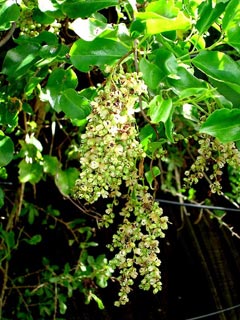 Muehlenbeckia australis (illustrated on the right) has the dubious distinction of being described as "one of the few native species that can be considered a weed under some circumstances" (Bruce Roy et al., Common Weeds, p. 236). From our experience at Te Māra Reo, I would say this reputation is well deserved! This vine stretches ten metres or more up trees, with a main stem up to 10 cm in diameter, with slender branches twining through the supporting foliage -- if there is nothing to hold on to, the plant will form a tangled mass. With smaller trees, it can completely cover and smother them or cause them to collapse (or both). Its shiny green leaves are up to 8 cm long by 3 cm wide, on 2 to 3 cm stalks. The size of its leaves has resulted in alternative name, puka, a word which functions like pōhuehue as a generic term as well as a name for specific plants. The flowers are similar in form to those of M. complexa, but greenish and borne in long panicles, the swollen female flowers each holding a single shiny black seed when they bear fruit. M. australis is the only Muehlenbeckia to be found naturally on the Chatham Islands. Muehlenbeckia australis (illustrated on the right) has the dubious distinction of being described as "one of the few native species that can be considered a weed under some circumstances" (Bruce Roy et al., Common Weeds, p. 236). From our experience at Te Māra Reo, I would say this reputation is well deserved! This vine stretches ten metres or more up trees, with a main stem up to 10 cm in diameter, with slender branches twining through the supporting foliage -- if there is nothing to hold on to, the plant will form a tangled mass. With smaller trees, it can completely cover and smother them or cause them to collapse (or both). Its shiny green leaves are up to 8 cm long by 3 cm wide, on 2 to 3 cm stalks. The size of its leaves has resulted in alternative name, puka, a word which functions like pōhuehue as a generic term as well as a name for specific plants. The flowers are similar in form to those of M. complexa, but greenish and borne in long panicles, the swollen female flowers each holding a single shiny black seed when they bear fruit. M. australis is the only Muehlenbeckia to be found naturally on the Chatham Islands.
Muehlenbeckia axillaris, generally known only as pōhuehue, is essentially a creeper, with stems and branches travelling underground or rooting on the surface where they can take a hold, forming tangled patches up to a metre in all directions in favourable spots, or emerging sporadically above the surface in less favourable terrain. It is a plant of the mountains, inhabiting the edges of river beds and rocky or gravelly places at higher altitudes in the North and South Islands from the Volcanic Plateau south. Its small flowers, appearing singly or in pairs, are very like those of M. complexa, the female flowers either swollen and icy-looking, or sometimes rather dried out when fruiting. As with the other Muehlenbeckias, each fruiting flower has a single seed. There is a photograph in the gallery below.
Hoki atu ki runga -- Go back to the top of the page.
|

